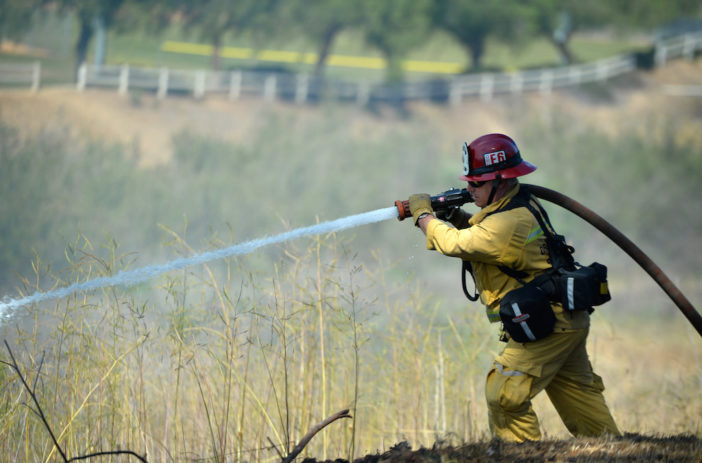In firefighter lingo it’s called “extreme fire behavior,” and just a year ago Orange County firefighters witnessed and battled it for 12 excruciating, exhausting days.
By the time it was declared 100 percent contained on Nov. 7, 2020, the Silverado Fire had torched 13,390 acres and caused the evacuation of 90,000 residents.
Captain Greg Barta remembers seeing the fire from the command post of the Orange County Fire Authority (OCFA) where he was coordinating communications.
“That fire was moving at hyperspeed, at such a pace we couldn’t stop it,” he recalls.
It is a situation that may become more common than rare in the firefighting community and it reinforces the importance for the community of staying informed and prepared.
To fill this vital need, groups such as Ready OC, Orange County’s emergency preparedness resource, keep the community informed and ready. Through the website, residents can learn how to prepare emergency kits and go bags for any kind of disaster, including floods, earthquakes and tsunamis. ReadyOC also contains links to sites like Alert OC where residents can sign up to learn about emergencies in their local communities.
Raging inferno
On the days in late October and early November in 2020, Barta witnessed the classic features of extreme fire behavior. There were massive crowns and legs of flame shooting skyward. There were fire whirls, or cyclones of flame, dust, and ash, as the fire created its own internal and terrifying weather systems and phenomena.
It was a nightmare-scape, like something from the mind of Dante or the brush of Sandro Botticelli.
Except it was very real.
Barta called it the “perfect storm” of drought-starved vegetation and remorseless Santa Ana winds.
“The winds were extraordinary even by Santa Ana standards,” OCFA Chief Brian Fennessy told NBC at the time. “Fire-spread is exceeding more than anything I’ve seen in my 44 years.”
It was a year during which nearly 75 fires of more than 1,000 acres were reported statewide and nationally more than 9,300 fires of all sizes burned between 4.1 and 4.4 million acres as reported to Cal Fire and the U.S. Forest Service.
It might have seemed at the time that Santiago was a capstone to a calendar year of fire like no other.
Having witnessed and endured the ferocity of Silverado, Barta could never have imagined that just one month later he would go through it all again when the Bond Fire tore through Santiago Canyon. That nine-day blaze took another 6,600 acres and was stopped, ironically, in part by the fire scar from Silverado.
One of the miracles of the Silverado fire was that no civilians were killed, although two firefighters were injured and badly burned.
Lessons learned
It is said that every fire teaches, and that was the case with Silverado, Barta said.
“It reinforced that residents were following the mnemonic plan we developed of ‘Ready, Set, Go,’” Barta said. “Citizens did a great job with Ready, Set, Go, and being informed.”
Barta said the fire authority had also learned its lessons from fires past, including the 2007 Santiago Fire that burned more than 28,000 acres.
“There’s always a lesson,” Barta said. “I was at the command post and they knew the path the fire would take and were able to deploy our resources in tactically advantageous locations.”
Since the fire, OCFA has also unveiled an aerial Quick Reaction Force that coordinates use of two helitankers among the largest in the world that can each carry up to 3,000 gallons of water or retardant, another that carries up to 1,000 gallons of water or retardant, an intelligence and recon helicopter, and a mobile retardant base that can actively mix up to 18,000 gallons of retardant per hour. The force is also able to operate at night, which is new. The program is shared between the Orange County, L.A. County and Ventura fire agencies. Southern California Edison helped pay for the program with an $18 million grant to lease the equipment for three years.
In 2020, the Santa Ana winds were so strong aircraft could not safely operate, Barta said.
Citizen involvement
Barta says residents can play a huge role in limiting damage and danger through being proactive.
Readiness, he says, should be practiced year-round. One key, he says, for homeowners to “give your house the best chance,” is to cut away vegetation from near the house, clearing 100 feet if possible. Thinning or removing dead or dying plants and planting less flammable plants can also reduce the path fire can take to your home.
Also key are home hardening strategies, which are easy ways to protect your home and are explained on the OCFA website.
Fire officials say as part of being “set,” residents should have valuables, documents, and pets in place if an evacuation is called.
And if the call comes, you’ve gotta go.
“We don’t give evacuation orders easily,” Barta said. But they are vital.
This is particularly true in some of the canyons in Orange County where roads are narrow and access can be tricky in the best of times for large equipment.
Barta also urges people not to try to become amateur firefighters.
“We understand the desire to stay and defend what’s likely your largest tangible asset,” he said. “No physical asset is worth potentially losing your life.”
And if homeowners and residents are overtaken by fire, it compounds the issues for firefighters and takes them away from fighting the fire.
“Our number one priority is always life safety,” Barta said.
Southern California Edison pitches in
Utilities have been besieged in recent years for their roles, real and perceived, in wildfires. Southern California Edison said it is fighting hard to provide safety solutions. The utility has undertaken a number of efforts to protect customers and communities.
In 2018, Southern California Edison introduced a $582 million Grid Safety and Resiliency Program (GS&RP) that aligned with wildfire mitigation plans enacted by the state.
Among its work in “grid hardening” has been replacing bare power lines and conductors with insulated ones, particularly in fire prone or vulnerable areas. The new hardware is effective in “making blowing debris less problematic and allowing higher thresholds for wind speeds,” according to Southern California Edison.
It has also worked to improve its software and switching to reduce the time and size of areas affected when public safety power shutoffs are required.
Southern California Edison also offers programs, information, and rebates to help residents prepare for emergencies.
Coda
Fire officials know that living in a state of heightened alert is simply the price paid to live in the beauty of Southern California.
Drought, heat, climate change, unpredictable weather patterns, and encroachment into the urban wildland interface have all become part of life and changed the fundamental nature of fires, management and suppression in California.
Locally, officials have taken lessons from the Silverado fire, beefing up their suppression equipment, techniques, and learning with each engagement.
But the fact remains that fire is ever present and will affect life in California for years to come. This year’s Dixie Fire incinerated 963,000 acres and ranks No. 2 behind last year’s August Complex Fire. The seven largest wildfires in California have occurred since 2018.
For Orange County residents, the reality of wildfires is also historic. Likely the largest-ever fire in the state before 2018 was the Santiago Fire of 1889 which blackened large swaths of Orange and San Diego counties. Its 300,000 acres burned is only an estimate, as records were not kept at the time.
To date in 2021, despite another year of debilitating drought, Orange County has been spared substantial fire. But as residents and firefighters know, the next conflagration is only a spark away.
 Behind the Badge
Behind the Badge



